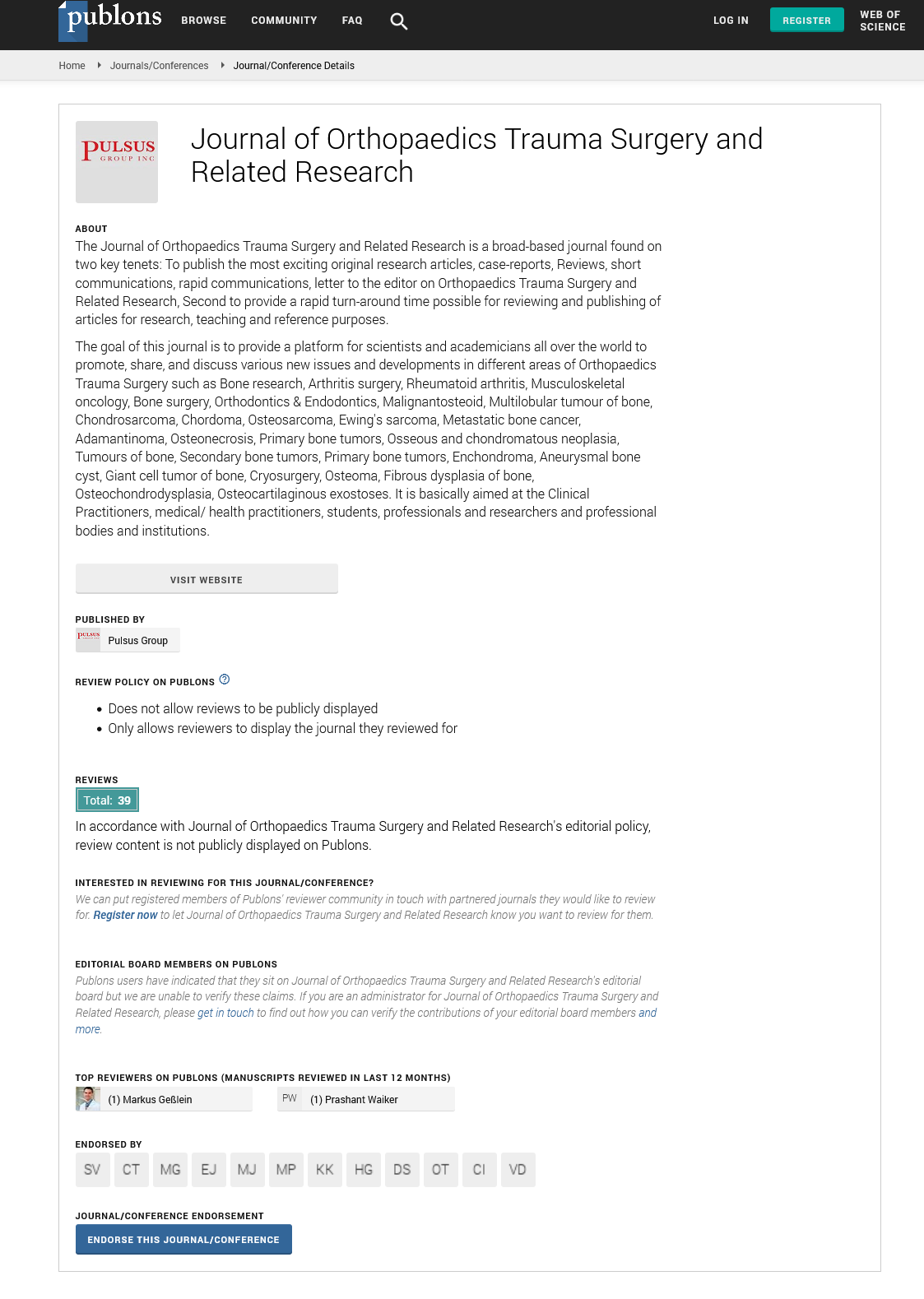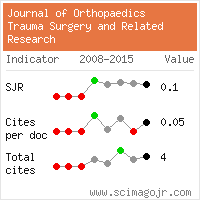Level of complete prescription for amonocentric prosthetic free knee joint among transfemoral amputees in mbale hospital orthopaedic workshop
Received: 11-Jun-2022, Manuscript No. jotsrr-22- 74463; Editor assigned: 12-Jun-2022, Pre QC No. jotsrr-22- 74463 (PQ); Accepted Date: Jul 08, 2022 ; Reviewed: 26-Jun-2022 QC No. jotsrr-22- 74463 (Q); Revised: 03-Jul-2022, Manuscript No. jotsrr-22- 74463 (R); Published: 09-Jul-2022, DOI: 10.37532/1897- 2276.2022.17(6).72
This open-access article is distributed under the terms of the Creative Commons Attribution Non-Commercial License (CC BY-NC) (http://creativecommons.org/licenses/by-nc/4.0/), which permits reuse, distribution and reproduction of the article, provided that the original work is properly cited and the reuse is restricted to noncommercial purposes. For commercial reuse, contact reprints@pulsus.com
Abstract
The general objective in this study was to assess the level of complete prescription of monocentric free knee joint among TF amputees in Mbale Hospital Orthopaedic workshop. Specific Objectives included; determining the prevalence of transfemoral amputees attending Mbale hospital Orthopaedic workshop, ascertaining the post gait training of a new monocentric free knee joint users in Mbale hospital Orthopaedic workshop and assessing the challenges of a monocentric free knee joint among TF amputees in Mbale hospital Orthopaedic workshop. Using a cross sectional study design,a sample size of 30 respondents was enrolled using convinient sampling method. Informed consents were obtained from the study participants before enrollment. Data was collected using questionnaires. Quantitative data was presented in frequency tables and piecharts while as qualitative data was presented inform of narrations, descriptions or texts. The findings showed thatout of a sample of 30 participants, majority were male 19 (63.3%) and the rest were females, most of them were aged between 30 years -50 years 18(59.26%) and majority were staying in urban areas making up 60%.Those that were Non-civil servant employed were 18 (60%) of the sample and when it came to marital status, majority of them were married 18 (60%).
As well majority of the TF amputee fitted with a prosthesis using a monocentric knee joint are unilateral amputee making 93.33%. The results revealed that majority of the Trans femoral amputees were gait trained from the Orthopaedic workshop area with 25(83.3%), did not walk freely with the prosthesis having a monocentric knee joint and experienced hardships when walking with 20(66.7%), and walked slowly were 25(83.3%). Almost all the unilateral or bilateral Transfemoral amputees with prostheses were observed ambulating during gait training by the prosthetist with 30(100%) and their steps taken were asymmetrical 27(90%), some walked due to fear of falling and lack of stability as seen. Majority of the Transfemoral amputees experienced problems with the prosthesis they were using with 25(83.3%) and most amputees used their own muscles to remain stable while standing (with no stance control) with 14(45.84%).
Keywords
assistive technology, amputation, hemicorporectomy, rehabilitation, prosthesis, case report
Introduction
Globally and in the United States, in the study conducted by Steven A. Gard (2016), it was demonstrated that the transfemoral prostheses are intended to restore function and cosmesis in persons with limb loss. Lower-limb prostheses are generally intended to restore ambulation, a periodic activity in which the primary concern for the device is for the provision of natural, efficient movement. Of all the elements affecting locomotion, those most amenable to change relate to the device; thus, in the description of walking patterns, emphasis should be placed on prosthetic design, alignment, and fit. The designs of commercially available prosthetic knee units are generally biomimetic in nature, and their functions are fundamentally similar to the prosthetic knee must provide stability during stance phase to ensure that the user is safely supported on their prosthesis, and it must flex during swing phase to shorten the prosthesis and allow the user to advance the limb. However, different prosthetic knee designs offer different features above and beyond these minimum requirements, and selection of a particular knee joint depends upon an individual’s functional needs and abilities [1-3].
A monocentric knee joint or single-axis knees or sometimes called “constant friction” knees are the most basic of prosthetic knee designs. They are simple hinge mechanisms that allow for free knee flexion, with a friction adjustment that is set by the prosthetist according to the swing- phase requirements of the patient. The lack of swing-phase control permits only a single fixed cadence, and the lack of stance control requires that the user to rely on their muscle power to some extent in order to stabilize the knee joint during walking. The primary advantages of single-axis knees include low cost, light weight, reliability, and relative durability because of their simplicity. Single axis knees are prescribed for children, who tend to be very energetic and outgrow their prostheses quickly, and for individuals who tend to walk at the same speed all of the time. Because of their simplicity and reliability, single-axis knees are also a good choice for persons who do not live close to a prosthetic facility and cannot come in regularly for maintenance of their prosthesis.
Though monocentric knee joints are positive in United States, African Nations are so indebted to Jaipur limb Technology that Kenya Government issued a stamp in their country with an amputee fitted with Jaipur foot. Recently, the world society of designers have selected seven designs from all over world which have improved or likely to improve quality of life of world population. This is called “World Design Impact Award”, it was demonstrated that one of the finalists from out of seven designs chosen from all over world is Polycentric knee joint developed by BMVSS of Jaipur (Mahendra Kishore Mathur, 2012).
In Uganda and at Mbale hospital, it has been observed that majority of the transfemoral amputees using monocentric free knee joints experience or have history of falling consistently which has resulted into other injuries (records June 2019-January 2020). This is in part related to the fact that the free knee monocentric joint does not have stability and lacks a mimic of anatomical movements i.e. extension and flexion. Therefore the present study seeks to determine the prevalence of TF amputees using prostheses with a free monocentric knee joint, ascertain the post gait training of a new monocentric free knee joint users and challenges of a monocentric free knee joint among TF amputees in Mbale hospital Orthopaedic workshop [4-7]
PROBLEM STATEMENT
From observation, majority of the amputees using monocentric free knee joints reporting at Mbale hospital orthopedic workshop usually have history of falls which has resulted into other injuries like bruises, fractures, reduced muscle power and contractures(records June 2019-January 2020). This could be attributed to the fact that free knee monocentric joints do not have stability and lack a mimic of anatomical movements i.e. extension and flexion. The hospital administration through the orthopedic workshop management have tried to introduce knee locks to a free monocentric knee joint which further distorts the anatomical movements of the device and hence more falls. Therefore the present study seeks to determine the prevalence of TF amputees using a free monocentric knee joint, ascertain the post gait training of a new monocentric free knee joint users and challenges of a monocentric free knee joint among TF amputees in Mable hospital Orthopaedic workshop [8].
During patient evaluation and examination that follows the determination level of which knee joint type would be prescribed for the TF amputees received at Mbale regional referral hospital, a number of factors must be put into consideration as follows; Muscle power, Stability on the ground Age of the TF amputee Stump, size, Occupation, Desired functionality [9].
The above mentioned factors will help in the proper level of prescription of a monocentric knee joint for TF amputees who can afford mobility with it and can control the prosthesis effectively. Using a manual lock to compensate for lack of stance control would as well be done to reduce on the instability during standing.
Proper gait training, supervision, observation and adequate time should be given for the TF amputee to effectively learn how to use the prosthesis before being discharged by the prosthetist.
All later alignment adjustments required as observed during all the sequences of gait training should be done before discharging the amputee. All the TF amputees’ complains and questioned should be addressed by the prosthetist during gait training [10].
References
- Gil JA, Wawrzynski J, Waryasz GR. Orthopedic manifestations of ochronosis: pathophysiology, presentation, diagnosis, and management. Am J Med 2016;129:536.e1-6. [Google Scholar][CrossRef]
- Mannoni A, Selvi E, Lorenzini S, et al. Alkaptonuria, ochronosis, and ochronotic arthropathy. Semin Arthritis Rheum 2004;33:239-48. [Google Scholar] [CrossRef]
- Rasul Jr AT, Fischer DA. Primary repair of quadriceps tendon ruptures. Results of treatment. Clin Orthop Relat Res Apr 1993(289):205-7. [Google Scholar][CrossRef]
- McNeilan RJ, Flanigan DC. Quadriceps Tendon Ruptures. In Hamstring Quadriceps Inj Athl. 2014, 103-19. [Google Scholar][CrossRef]
- La Du BN, Zannoni VG, Laster L et al. The nature of the defect in tyrosine metabolism in alkaptonuria. J Biol Chem 1958; 230: 251-60. [Google Scholar] [CrossRef]
- O'Brien WM, La Du BN, Bunim JJ. Biochemical, pathologic and clinical aspects of alkaptonuria, ochronosis and ochronotic arthropathy: review of world literature (1584-1962). Am J Med 1963;34:813-38. [GoogleScholar][CrossRef]
- Phornphutkul C, Introne WJ, Perry MB, et al. Natural history of alkaptonuria. N Engl J Med 2002; 347: 2111-21. [Google Scholar][CrossRef]
- Zannoni VG, Lomtevas N, Goldfinger S. Oxidation of homogentisic acid to ochronotic pigment in connective tissue. Biochim Biophys Acta 1969;177: 94-105 [Google Scholar][CrossRef]
- Lorenzini S, Mannoni A, Selvi E et al. Alkaptonuria. N Engl J Med. 2003; 348(14):1408. [Google Scholar][CrossRef]
- Aydogdu S, Cullu E, Ozsoy MG, et al. Cementless total knee arthroplasty in ochronotic arthropathy: a case report with four-year follow-up. J Arthroplasty 2000;15:539-43. [Google Scholar][CrossRef]



 Journal of Orthopaedics Trauma Surgery and Related Research a publication of Polish Society, is a peer-reviewed online journal with quaterly print on demand compilation of issues published.
Journal of Orthopaedics Trauma Surgery and Related Research a publication of Polish Society, is a peer-reviewed online journal with quaterly print on demand compilation of issues published.